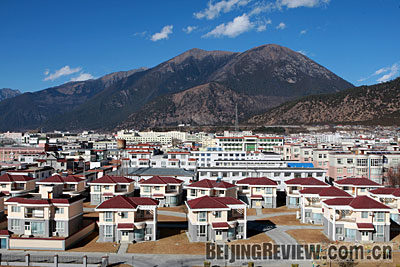|
 |
|
COZY HOMES: More Tibetan farmers and herdsmen have moved into new houses funded by the government in Nyingchi (JIANG XIAOYING) |
Since 1959's democratic reform, the Central Government has been pumping money into Tibet in hopes of quickly lifting the region out of economic limbo.
In an act of solidarity, the governments of other Chinese provinces in 1994 were called on to chip in for the effort and offer real support for Tibet's economic and social development. Since that moment, aiding Tibet has become a tradition for its sister provinces that has been kindled over successive years. Shanghai and the coastal Shandong Province, for example, are responsible for supporting the economic development of Xigaze, the second biggest city in Tibet.
Pumped-up harvests
Scientists and experts in a number of fields hailing from all over China have imported many new skills to the remote region in the past decades. Shandong experts taught Tibetans how to efficiently grow vegetables using greenhouses in addition to building roads and public facilities.
Puqiong, a father of three, grows squash, tomatoes and water melons in his four greenhouses, which together provide 200 square-meters of growing space. The Central Government invests 12,000 yuan ($1,757) to build and equip every greenhouse. Farmers can then purchase the facility at the subsidized rate of 500 yuan ($73) each.
"Growing vegetables is a much more profitable practice than growing highland barley," Puqiong said, holding freshly picked squash in his hand. He earns 30,000 yuan ($4,400) a year from farming, enough to cover all his family's expenses. He used to earn a 10th of that, barely enough to make ends meet.
Before agriculture experts introduced these new techniques, vegetables were more expensive than mutton or beef, as they needed to be flown in from other parts of the country. Locals said they were tired of eating meat every day and happy that their more diversified diet keeps them healthier. Thanks to the greenhouses, Tibet's annual vegetable output reaches 550,000 tons including over 110 varieties.
Moreover, Tibet has become known as a pollution-free agricultural area, endowed with copious sunshine and little need for pesticides. Its cabbages, potatoes and garlic are transported to other cities and exported to neighboring countries like Nepal.
Harnessing the sun
Tibet sits at the highest elevations in the world and is bathed in the most solar energy in all of China. The region accumulates more than 3,000 hours of sunshine each year. And Tibetans are harnessing that power. By the end of 2008, there were 250,000 solar-powered stoves. The government covers nearly all expenses associated with the equipment, including the installation fee.
 |
|
MORE CHOICES: A Tibetan woman buys vegetables at Yaowangshan Food Market. The Tibetan diet has grown more diverse in the last few decades (JIANG XIAOYING) |
Tibet's economic improvement has been restrained by a shortage of energy. Tibetan families used to burn animal feces to heat up water and make dinner. Though some rural residents retain that tradition, many are turning to solar power for heat and fuel.
Gyangze County resident Kerong now boils water on a solar stove instead of using animal dung for fuel. Kerong said he was overwhelmed by the new water heater because it is clean, easy to operate and saves him lots of time.
"I don't have to smell the smoke of yak dung burning anymore," Kerong laughed.
But he envies people in other villages who have more advanced solar stoves installed in their courtyards.
"They can cook, stew and fry in those smart stoves," Kerong said. "And all their expenses are covered by the government."
A 1.6 square-meter solar stove can save 1,284 yuan ($188) a year per household-equal to a third of Tibet's per-capita income-compared to burning animal feces and firewood, said Chen Xinqiang, a senior official of Tibet Autonomous Region's Science and Technology Bureau.
"Using solar power is more convenient and environmentally friendly," Chen said. "The government will expand the application of solar power in Tibet to make full use of the plateau sunshine." | 